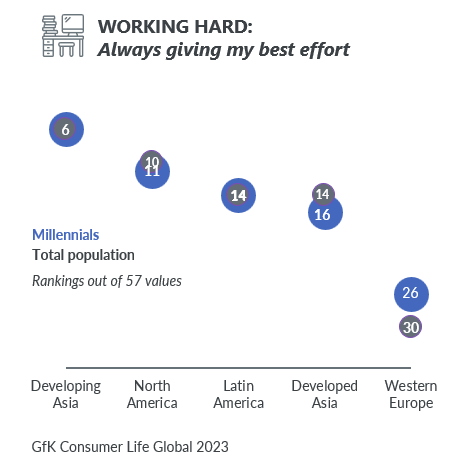More than half of the world’s eight billion people were born in the last four decades, putting them in the Gen Z or Millennial generations. They share a history of economic turmoil and rapid technological change that has shaped the ways they view the world, but there are also clear differences in their attitudes, values and behaviors.
As these two consumer cohorts prepare to unleash their full purchasing power, we analyze data from our latest GfK Consumer Life Global report to reveal what defines them, what divides them and what brands can do to win them over.
Purchasing power and potential
The birth dates of different generations are not set in stone, but at GfK we consider a Millennial to be someone born between 1980 and 1997 and a Gen Z to be someone born between 1998 and 2012.
Having recently overtaken Boomers to become the world’s biggest generation, Millennials are entering their prime earning and spending years. As a cohort, they have only average incomes but, as 29% of the world’s population, they comprise a large share of worldwide buying power and this will likely grow as they advance their careers. Together, the income of Millennials is projected to hit the $15 trillion mark in 2023, putting them on a par with Gen X, whose income they are poised to surpass over the next decade.

Gen Z is not yet in full consumption mode, but it’s not too early for marketers to be ready for this game-changing generation of shoppers. Their economic power is the fastest-growing in the world, according to the Bank of America, which estimated in 2020 that it would balloon by 400% over the next decade to $33 trillion, surpassing the spending power of Millennials in 2031.
Making up 17% of the population in developed regions and 25% in developing regions, Gen Z – also known as ‘Zillennials’ – have big aspirations and high expectations. While the economic climate, global mobility and types of jobs will influence when they start having families and buying cars and homes, they are already making many purchases on a regular basis and express an intent to make larger ones nearly on par with Millennials.
Feelings about the future
Most Millennials will remember a time when the global economy was more stable, but Gen Z has grown up in the long shadow of the 2007–2008 financial crisis only to be hit by a pandemic that shut down economies worldwide. No wonder they are more wary about the macro environment than the generation before them.

The contrast between generations is most striking in the Americas where only 28% of North American Gen Z are optimistic about the future of the economy compared with 40% of Millennials. The difference between Gen Z and Millennials is smaller than those in LATAM (20% among Zers vs. 25% Millennials) and Developing Asia (58% vs. 64%).
In Western Europe, the two cohorts are more evenly matched, sharing a generally muted outlook, though their peers in Developed Asian economies are the gloomiest. Brands can capitalize on optimistic markets while adapting their messaging to rationalize with more cautious sentiments in other regions, particularly among the youngest generation.
The world of work
A healthy work/life balance matters to people of all ages these days, but the younger generations have particularly high expectations that employers will deliver it. For many Gen Z, work is not just about a paycheck, but an opportunity for growth, a sense of fulfillment, and sometimes a creative outlet.
That doesn’t mean young people don’t care about money. Both Gen Z and Millennials regard fair pay as the number one responsibility of companies, whereas Generation X demotes this to second place and Boomers to third place.
For Millennials, many of whom want to settle down and raise families, pay is a dealbreaker. Though they are drawn to employers by the promise of work/life balance and development opportunities, pay is the biggest reason why they will leave a job.
Employers once branded this generation ‘entitled’ and ‘work-shy’ but as they mature, Millennials are shrugging off the stereotype. Indeed, GfK research shows that they prize hard work and effort as much as the rest of us. The same is generally true for perseverance, which is rated higher than average among North American Millennials. This age group also places a higher-than-average value on ambition in most parts of the world, although this tends to be a lower priority overall.
Brands need to recognize that Zillennials and Millennials juggle their idealism and pragmatism about work in different ways. While both are demanding a better value proposition from employers, Millennials are more focused on bringing home a living wage, especially if they are parents.

Varying values
Gen Z values creativity and curiosity more than older consumers do and, as lifelong digital natives with an abundance of tech and media tools at their fingertips, they can find inspiration anywhere.
Covid-19 lockdowns and the rise of social media have left their mark on this mobile-first generation. A quarter of Zillennials say they have felt lonely in the past month, seven percentage points above the global average. While digital connections remain a critical part of life, many Gen Zers have also come to the recognition that virtual reactions have limitations. Our data shows that the statement ‘virtual interactions can be as good as being there in person’ is the second least agreed upon life attitude among Gen Z as among the overall population. When younger generations do look for brand interactions in the virtual space, they tend to favor conversational brands that engage with them in real time through novel, personalized experiences.

Not to be outdone by the young ones, Millennials too are a tech-savvy bunch. But they show their digital confidence in a different way. For example, Millennials are more likely than the rest of the population to use an electronic wallet on a mobile phone, make an online purchase using a Buy Now, Pay Later app, or trade in cryptocurrency. Having taken a bigger financial hit during the pandemic than their parents and grandparents, they are also a thrifty generation – more likely than average to buy second hand, shop at discount stores and hold off purchases till a sale. Some of these shopping behaviors are particularly common in western markets, especially North America, where 58% of Millennials shopped more at discounters and 54% bought something secondhand in the past year.
Brands can resonate by offering Millennials practical tech solutions that simplify their busy lives and help them save money.
The world on their shoulders
Maturing in an era of unprecedented global challenges, Gen Z and Millennials are comfortable with change and navigate it in the inimitable styles that define their generations – balancing idealism with pragmatism, setting high standards for business and leveraging the latest technology. Brands that can tune in and keep up will tap into vast consumer power and potential.
Celebrating its 25th anniversary, the Consumer Life Global report is the longest-standing consumer trend study in the world.




